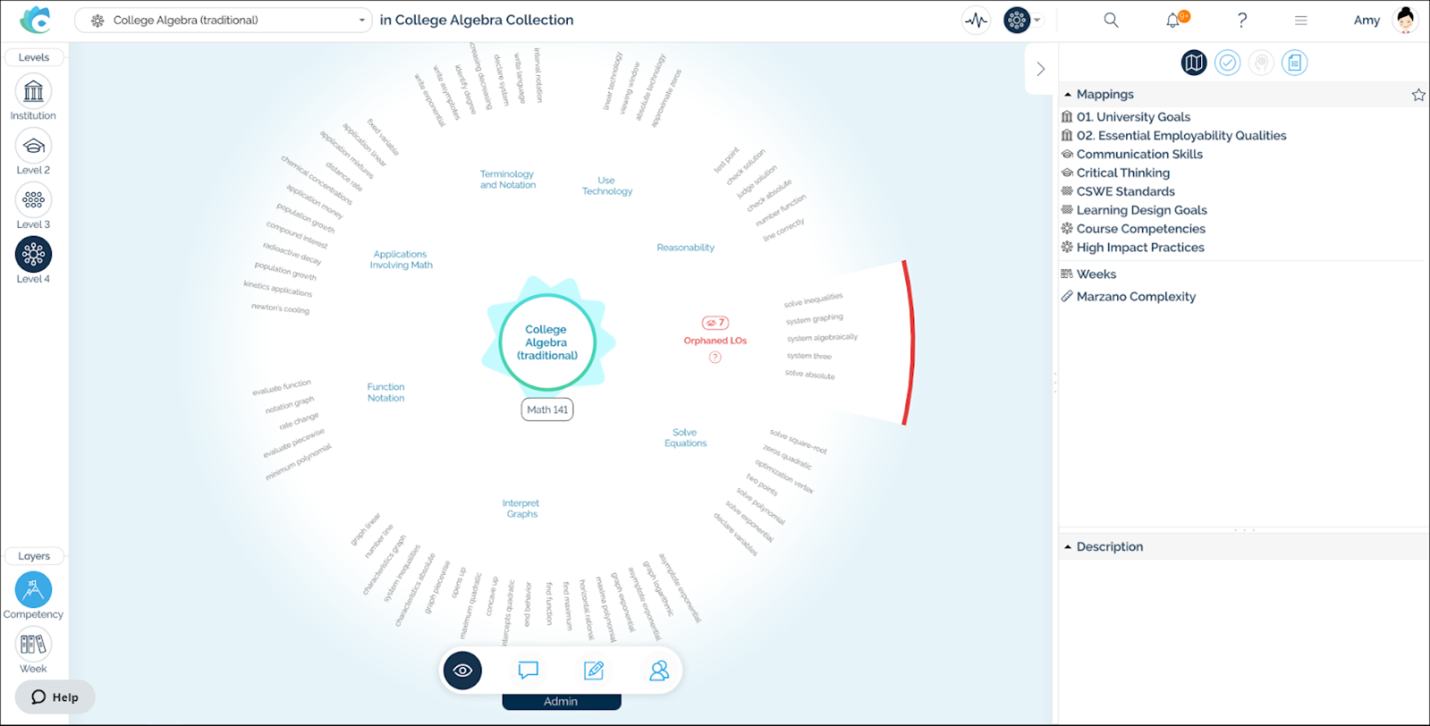
As you begin to use Coursetune, you’ll realize that the power of the tool guides you through mapping your course in a more detailed way than you’ve ever done before. Let’s look at a common scenario we see across the Coursetune Community: duplicate Learning Objectives (LOs).
The Coursetune graph shows student progression through the course concepts (Read up on scaffolding).
If a Learning Objective exists in Module 1 (what we generically call a bundle in Coursetune) and is duplicated in Module 5 and Module 8, this is an indicator of what we call a “Muddy Path” for learning. For good design, rewrite those Learning Objectives to describe how the student will progress down the learning path over time. Ask yourself how the success indicator or the Bloom’s verb is different between Modules 1, 5, and 8. This will help you recognize how and why you should write your Learning Objectives differently.
When the learning objective is duplicated in several modules, we will also see the LO duplicates on the course goals (what we generically call the C-layer). Again, it’s more beneficial for students and faculty to see the progression of distinct LOs that meet a course goal.
Here’s why: duplicate Learning Objectives muddy the learning path and may not translate well to other stakeholders. Consider the adjunct who teaches the course you’ve built – will they understand that the duplicated LOs are really a scaffolded set of objectives showing growth over multiple engagements? The lack of careful LO articulation can negatively impact the learning experience if instructors can’t read between into the true meaning of the duplicated LOs.

A Muddy Learning Objective Path
A Muddy Learning Objective Path
Let’s say you’ve designed a human anatomy course with 5 units. The Learning Objective “Understand the digestive system.” is listed in five different units. Do you mean for students to reach this objective at the end of the first unit and then repeat it five times exactly the same way? Or perhaps students learn about how the digestive system affects different parts of the body in each unit?
If every unit of your course has this same objective, it will not be clear if your students are achieving the goal at the close of every unit. Importantly, it will not be clear to your students if they are progressing as expected through the course (Read more about writing effective learning objectives).
Because you’re working towards meeting bigger course-level competencies over the duration of an entire course, revisiting learning concepts in multiple units is absolutely what you want to do, but not with an identical statement. Imagine it from the student perspective; you won’t actually be covering the exact same objective each week. In fact, you will be progressing. You will be building a scaffolding on that learning sequence. More detail not only clarifies the intention behind the learning path, but also ensures that students are building relevant skills in an appropriate way (Read more on the importance of interleaving concepts).
Creating Signposts in Our Curriculum Design
Creating Signposts in Our Curriculum Design
How can we write our Learning Objectives in a way that creates clear signposts for our learning path? Well, while we know what our overall Learning Objective for the course is, we can look at each unit to derive more discrete Learning Objectives for each unit. Look at the chart below to get an idea of what this could look like:
 |
||
|
Course Unit |
Original Design: Many repeats of the same LO (a.k.a., “The Muddy Path”) |
Clearer Design: Gradual increase in difficulty and targeted context creating clear signposts |
|
Unit 1: Meet the Human Body |
Understand the digestive system. |
List the organs of the digestive system. Locate the organs of the digestive system on the human body. |
|
Unit 2: Functionality of Organs |
Understand the digestive system. |
Describe the purpose of each organ in the digestive system. |
|
Unit 3: Processing Nutrients |
Understand the digestive system. |
Explain how nutrients make their way through the digestive system. |
|
Unit 4: Nutrition and the body |
Understand the digestive system. |
Analyze how a change in nutrition might affect the digestive system. |
|
Unit 5: Diseases of the Body |
Understand the digestive system. |
List diseases that target the digestive system. Describe symptoms of disease that are related to the digestive system. |
Now that we can see how unique Learning Objectives can create clearer signposts on the curriculum pathway, let’s look at how we can find duplicate Learning Objectives in Coursetune and clean them up.
Clearing the Path – Finding Duplicate Learning Objectives in Coursetune
Let’s take a look at some ways you can use Coursetune to find duplicate Learning Objectives in your course design.
Finding Duplicate Learning Objectives in your C-layers:
The animation below shows you step-by-step directions on how you can find those duplicates in your c-layers. Checking this option in the Edit Course panel will turn all your duplicates red, if you follow these steps you’ll find them easy to locate.

Switching Between Layers:
You can switch between the bundles (delivery side of the course) and the C-layer (broad course goals side) easily by using the layer icons in the lower left corner. Check out the animation below to see how:

Orphaned Learning Objectives:
Whenever you create Learning Objectives on one side of your course, they will show as orphans on the other side. Since CourseTune nudges you toward one-to-one alignment between your delivery side and course goal side, the Learning Objectives are what can show those alignments. Drag the orphaned LOs into the course goals or units they align.

Bringing it All Together
Do I have to rewrite all of my duplicate learning objectives? The reality is that your time is precious. You may not be able to address this issue right now and that’s okay. You can continue building your maps with duplicate learning objectives. You can even select in some Coursetune reports to omit duplicate LOs. But you will eventually want to revisit this critical point.
One of the benefits of Coursetune is that it guides you toward more detailed curriculum maps, which can expose duplicate Learning Objectives within your courses. If you don’t clear up these duplicates, you’ll create a muddy learning path. The way forward is to create clear signposts on your learning path by using distinct Learning Objectives.
The good news? Coursetune gives you the tools to find and fix duplicates at both the Bundle and C-Layer.
Now you can go clean the mud off your learning paths and set the right signposts to show student progress.
Coursetune Can Help
Coursetune delivers a single visual resource that you can manage and update anytime from anywhere.
Coursetune helps you see how your outcomes align to your learning activities and assessments.
Using Coursetune, you can clearly communicate your curriculum plan to students, department heads, program managers and deans.
Want more details? Reach out to your ASP Academic Services consultant for more information.

